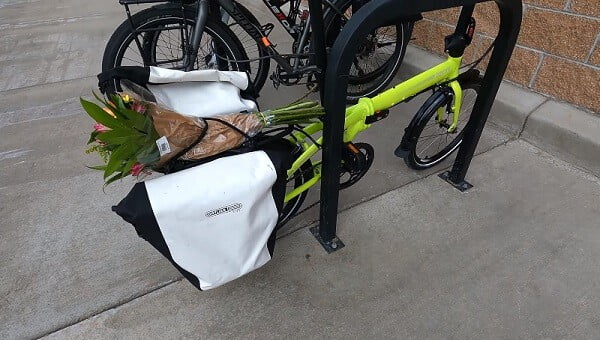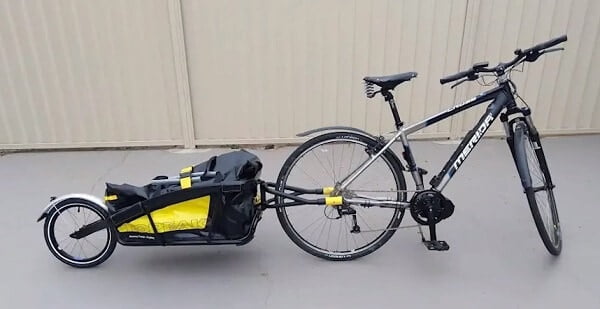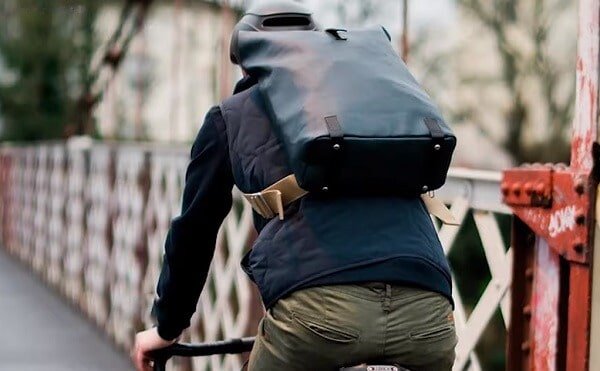There are lots of us who like to do everything on a bike, including shopping for groceries. However, it’s not as easy as it would be with a car. That is why we have prepared this article. Here we will give you important tips and advice on how to safely and conveniently carry your essential groceries on a bike.
How to transport groceries on a bike
1. Basket
The classic basket is something that many bike owners already use. You can mount one to the handlebars or to a rear rack. They are relatively cheap and easy to use since all you have to do is place your groceries on the basket and start pedaling. Depending on the number of items you carry, you might need to use bungee cords or straps to prevent anything from falling out.

2. Panniers
A pannier is a specialized bag for transporting things on a bike. They are mounted to the side of a bike rack and are very popular due to their practicality. Panniers are durable, have a high capacity, are easy to load and unload, can be carried using their handles, and provide protection from the rain. You can even mount two panniers on either side of a rack to double your capacity. However, they are a bit expensive.

3. Bike trailer
If what you want is ultimate carrying capacity, then a bike trailer is the one for you. They are pulled behind a bike, have one or two wheels, and can be attached to the base of the seat stays. Many people don’t like making frequent visits to the supermarket and instead, like to buy in bulk. With a bike trailer, you can make do with only one or two trips to the store every month. You can also use a trailer to bring along a pet or even your child with you on rides.

4. Backpack
A backpack is a staple item for carrying stuff around to places. Pretty much everyone owns a one or two. Why not use it for groceries as well? Their popularity stems from the fact that they are so convenient to use and that there are endless styles and sizes to choose from. Just sling one over your shoulders and off you go. The only downsides of backpacks are that they have less internal space and they can cause discomfort or back pain on longer rides.

5. Crates
If you have a spare plastic or wooden crate lying around the garage, you can use it on your bike in a similar way to a basket. You can use bungee cords or zip ties to secure it on top of your rear rack. Crates are quite durable and long-lasting. Even if you don’t have one, you can usually get one cheaply or even for free from a friend, neighbor, or a store.

6. Grocery bag with straps or cords
To bring back groceries without having to use any of the items mentioned above, you will need a good-quality grocery bag, a rear rack, and some straps/bungee cords. What you can do is buy what you need, fill up the grocery bag, and simply tie it down on the rack with the straps or bungee cords. However, you won’t be able to carry a whole lot and this is a less secure method.
7. Hanging on the handlebars
Another way to transport groceries is to simply hang the grocery bags on your handlebars. This method is free and doesn’t require anything extra, not even a rear rack or cords. The simplicity of this method comes at the cost of making the bike slightly difficult to handle due to the weight on the handlebars and the swinging of the bags. So, it is best to not have too much hanging off your handlebars.
Tips for grocery shopping on a bike
1. Plan ahead: It is important to plan beforehand what exactly you need to buy and where you need to go. This way you can utilize your limited space for only the most important items and make as few stops as possible.
2. Go to the nearest store: You might prefer shopping at a larger supermarket that is further away from your home than a smaller store nearby. However, since you will be cycling with a heavy load, it’s best to just go to what’s closest unless you have to.
3. Avoid inclines: Try and choose a path with the fewest slopes. If you are riding downhill on the way to the store, you will have to climb uphill with a loaded bike on the way back. That task can be harder than you think, so pick an easy route.
4. Cut down on excess packaging: You can easily avoid buying items that have a lot of useless packaging. These are usually processed foods that are not as good for you anyway. You’ll be saving valuable space, eating healthier, and reducing plastic waste all at the same time.
5. Pedal on a lower gear: Sometimes you are forced to pedal up an incline with a heavy load of groceries. If you have a bike with multiple gears, then you’re in luck. Simply shift to the lowest gear. You will be going slower but it won’t be as difficult to pedal.
6. Use higher tire pressures: The extra weight on your bike slightly increases the likelihood of getting a flat tire. To avoid this, you can pump more air into your tires. The higher pressure will prevent pinch flats, but be sure to not overdo it. You can also get wider tires if you want.
7. Take a break if needed: When the going gets tough, there is no shame in taking a short break to regain your stamina. You could also just walk your bike up a slope if pedaling becomes too difficult.
Some safety tips
1. Take it slow and steady: Riding with a good amount of weight on your bike can affect how well it handles. You’ll have to get used to it. But it is always a good idea to ride at a moderate pace and not rush too much. While maneuvering or cornering at high speeds, you could easily tip over and drop everything on the pavement.
2. Prepare for emergency bike maintenance: No matter how well you keep your bike maintained, there is always a chance of getting a mechanical or puncturing a tire. Therefore, you should learn how to deal with these yourself and carry some basic tools with you, especially if the distance is long. This way you can save time and hopefully get back home before all your ice cream melts.
3. Use a good set of brakes: Brakes are a crucial safety component on a bike. Always check your brakes and make sure that they are functioning properly. With a loaded bike, you will require a higher braking power to safely stop your bike when needed.
4. Ensure nothing is hanging off your bike: Before making your way back home, make sure that there are no straps or cords hanging down. Tuck them in properly as they can get tangled with the wheel spokes and cause a serious accident.
Frequently Asked Questions
Q1. Should I shop more often or buy in bulk?
Ans.: The answer depends on a few factors. If you live more than 15 minutes away from the nearest store and you have something with a high capacity such as panniers or a trailer, then buying in bulk might be more convenient. Conversely, if you only have a backpack, then you have no choice but to go grocery shopping multiple times a week. The choice is also up to your personal preference and schedule.
Q2. Can I combine baskets, panniers, trailers, etc.?
Ans.: You could have a trailer at the rear, a basket on the front, and a couple of panniers on the rack of your bike at the same time. While that will offer a huge carrying capacity, it will also make your trip to and from the supermarket a lot harder. You’d be pulling a lot of weight and it will be tricky maneuvering around traffic. If you have the stamina and the right route, then go for it. But make sure to cycle extra care to avoid any mishaps.
Q3. What are the benefits of grocery shopping on a bike?
Ans.: There are a few major advantages to cycling for grocery shopping. First of all, save money on fuel and public transport when riding a bike. Secondly, you are not contributing to carbon emissions and being more environmentally friendly by not driving a car. Additionally, cycling gets you out in the fresh air and you get some exercise as well. This is especially important for those who work in front of a desk all day. And finally, who doesn’t enjoy riding a bike!
Conclusion
Hopefully, now you will not hesitate to ride your bike to the grocery store. Be sure to follow the advice provided in this article and you will be able to transport everything efficiently and safely on your next trip. And as we have mentioned, riding a bike for everyday errands and commutes is a great way of life.
